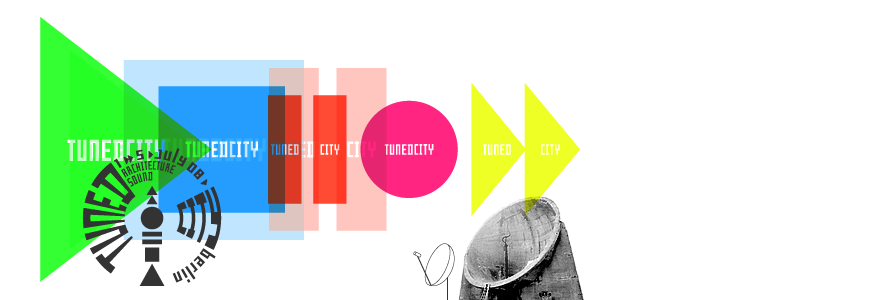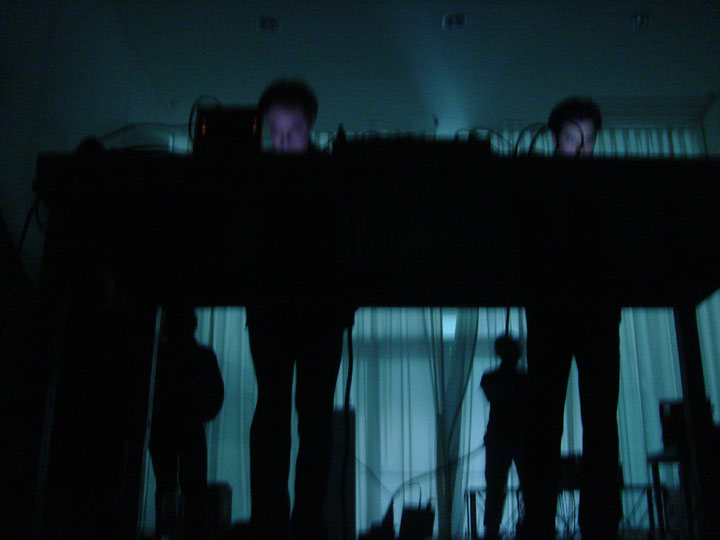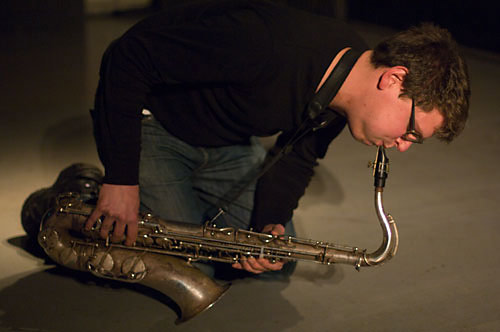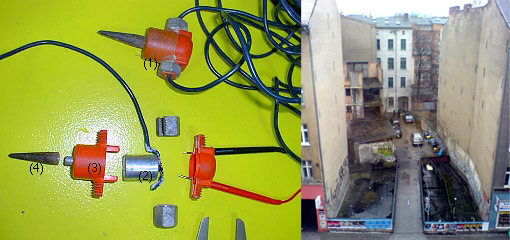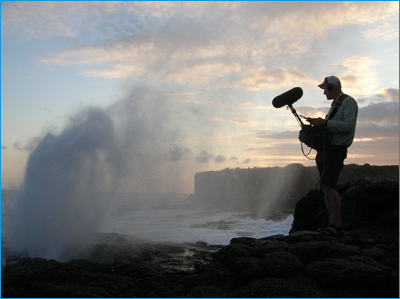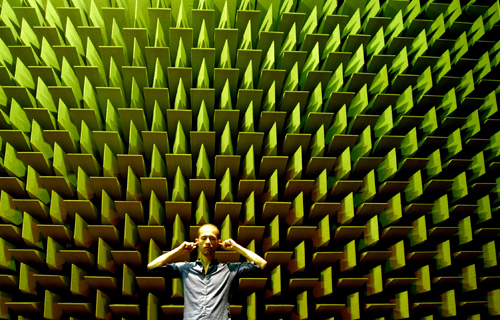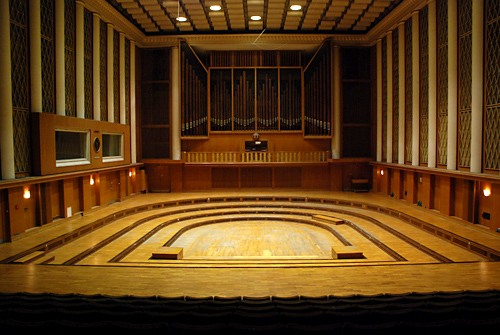Binaural Media Interview, 2006
Posted in Text on October 12th, 2008 by adminThe following interview was made by Mark McLaren of Binaural Media in January 2006, when I was very deeply involved with field recording and Pure Data programming. Others interviewed for the series include Chris Watson, Yannick Dauby, Julian Weaver, Francisco López and Marc Behrens. Interestingly enough, many of the same threads I’ve been writing about lately, namely the deterministic nature of technology on art, are present here as well.

Survey on Location and Context Based Media
1
Conducted by Mark Mclaren
January 2006
Many people are currently recording and working with environmental sounds. In recent years with the development of relativity cheap and portable equipment has enabled a wide variety of people to record and make use of the sounds around us.
From the more traditional idea of recording nature, to the ideas of amplifying the inaudible; from sound artists to architectural theorists all are becoming involved with an inter-disciplinary practice that has yet to fully investigated.
Binaural decided to commission a wide set of interviews with the aim of creating a contemporary overview of both the artists and their work. Many of these interviews are ongoing and Binaural though it important to make these texts available as they grow, so that hopefully the interviews link and learn from each other and develop into a variable resource for both those how are simply interesting in finding out more about the artists working in environmental sound, to those who wish to develop and deepen their understanding and practice.
By asking questions we are trying to move away from the untestable world of intuition of unspoken trial and error, to a create a dialogue where both listeners and composers can utilise some of the many techniques for listening that have long been available for written music. This survey hopes to develop into a comprehensive and open-ended meditation on the sounds that surround us and how the individuals that work with these sounds are creating their own rules, grammar and vocabulary.
Mark McLaren (MM): Tell me about the way you perform, specifically about the way you manipulate objects live to create sound?
Derek Holzer (DH): I got into working with sound objects and also with field recording a couple of years ago when I was in a Karosta, Latvia. I spent a very a long, cold month of December to January there. Everything was frozen, but everything was so still you could really pulls sounds out of the environment—sounds of water and ice. And I started to find things, all kinds of things—a lot of bones actually—and other strange objects, shells, chunks of metal. Things that seemed like they had history behind them, because I was in this place that was steeped in history—the history of the Tsarist era, the history of the Second World War, the history of the Soviet occupation and now the history of this handover to the EU and NATO regime. Everything I picked up seemed significant for some reason, so I began to stroke them and move them around and bang them together and see what kind of sounds would come out. And then I started to build up patches in the computer that would build up textures out of these sounds, and I thought these were very interesting sounds and I liked working with them a lot. At the same time, I was working with a group from Riga called Oloolo, and they came out to Karosta one day. We sat down and recorded this massive three hour jam session where I was working only with these objects and delays and filters and the ways of building up textures that I’d been creating, and they were playing some of their own work. They wound up taking the recordings and producing this album “Kosta”, that was released on Nexsound. I kind of forgot about it for a while, and then they wrote me almost a year later saying ‘oh, well we produced this album out of this jam and it’s going to be released’ and so I was really happy about this.
It was really a way of learning how to pick up objects and assess them for their sonic potential. I wound up using a lot of contact microphones, because that is a way to isolate an object from the surrounding acoustics ,but I also use a lot of close up miking, dynamic microphones to pick up the sound of them clinking together or the acoustics introduced inside of an object. If you have a shell or a bottle or something like that, I wanted to pick up how it transforms the sound inside of it. I also do a lot of field recording. I work as many people do, with binaural microphones that I wear in my ears so that I become a walking sound receiver, and I use a lot of those recordings as well.
Sometimes I use a lot more of those recordings than I use objects, it really depends on the circumstances. Setting up to do a live show where you’re really working with sound objects in this time honored electroacoustic manner actually takes a lot of preparation time, and sometimes you get a gig when you’re playing with five other people and they all want their set up time, so you’ve just got to do something very quickly. But given the time to set up, I like to work in this way—just finding objects from that place. I have some objects which I carry with me, some objects from Karosta and quite a few objects that I picked up during some travels in Brazil from the Amazonas regions, parts of fishes and shells and unidentifiable objects which are quite unique in the way that they look and the way that they sound. So they’re my lucky charms, and if I don’t find anything interesting in a place I can always pull these out and get something very interesting out of them.
MM: You mention that objects felt significant. Could you elaborate on this point? I notice a lot of works especially, location recording compositions, rely on this significance to almost create a false strength, to use the context as a crutch to composition.
DH: Hmmmm…. that’s a loaded question if I ever heard one! To start with, I don’t think that referencing signifiers which lay outside the “composition” proper is anything of a crutch. Follow that line of thinking for a while and you end up at the place where people say, “well, who cares as long as it sounds cool”. And I’ve never been comfortable conversing like that. From my first exposures to “experimental music”, I was always fascinated with the process of how sounds were arrived at, the kind of thought processes and backgrounds that a work had even if it were not obviously apparent in the composition, and especially what kind of “non-musical” objects were used and how they were treated. In short, I read liner notes like they were poems. This predates any aspirations of actually *making* sound myself in anything more than a self-satisfying, amateur, bedroom sort of way, so I wouldn’t even chalk it up to trying to bite anyone’s style.
On the other hand, this game of extra-compositional signifiers is exactly that… a game. By this I mean that it’s a situation that the listener enters into consensually with the artist. The listener agrees to accept certain elements which aren’t coming out of the speakers—textual cues, album art and other packaging or even fragments of the artist’s biography—as part of their whole experience of the work. I think this way of listening has deep precedents in the “serious music” world. Listen to classical radio, or open up any established composer’s CD notes, and then tell me that the contextual information about each composer provided doesn’t frame the listening experience. However, because it’s a game, you have to be careful not to strain your credibility, or else the whole suspension of disbelief you have built up in the listener will crash. The Acousmatician would argue that the sounds should stand up by themselves divorced of any reality or source-referent, or even any performative referent in the case of Lopez and co. But even in this case, you are asked to play the suspension game, and accept that the sounds exist as concrete objects disconnected from the world. And once again, you are back to extra-compositional cues which instruct your listening experience.
MM: Do you mean the significance helped you concentrate on playing with the object, or do you feel that there is some way that the historical significance of a place can be transferred to a listener purely by its sound?
DH: In the first place, I draw inspiration from the objects I find, and imagine small stories and sounds hidden inside them, and that, like little tape recorders, these objects have stored up the resonances of their various environments down to the subatomic level. My job then is to coax these resonances out and to make them audible. At times it is a very sonically-motivated approach, but there are times when it is a very historically-motivated one. For the Karosta recordings, I only used sounds and objects from a very specific location, and so I do think that the historical significance can be transferred to an aware listener. Mark Teppo, of Igloo magazine, wrote of the Oloolo collaboration “Kosta”: This is glitch theory being applied to the sound of history, the winds of old battlefields and abandoned cities being cut, spliced, and flung — scattershot — into the air.
MM: You say that you ‘build up textures in the computer’ is this in relation to a live manipulation or an off-line composition method? Please explain a little about the different approaches you have to improvising and to composing and ‘finishing’ pieces?
DH: My compositional process begins before I have picked up a single object or even turned on the microphone. I would say that the bulk of my time in the studio is spent building sound-processing tools in Pure Data. I simply don’t trust common, commercially available plug-ins simply because I feel like I’m working in someone else’s room. They’ve given me a table to sit at, but I can’t move it, and a window to look out, but I can’t open it, and a door to walk through, but only in the manner which they prescribe. I would prefer to build up my own tools, and know inside out how they work, rather than diddle with other people’s knobs and try out their presets. So the tools I build up create a set of improvisational and compositional possibilities that I can explore once I have brought objects or recordings to the situation.
A great many of these tools involve using delays or buffers to build up layers of sound, often from a microphone input or a recording on disk. I am much more interested in texture than strict rhythm or melody, and so I use my tools as a sonic microscope to isolate small sound particles of and magnify them. I took to an improvisational approach because otherwise I am too much of a perfectionist, and doing studio tracks usually takes much longer than I think it should, especially considering the time I’ve already spent programming. So I try to document the possibilities I’ve programmed into my tools, which is where I feel the real compositional work is for me, and then later on I can try to arrange them in a multi-tracker and get all anal-retentive “mastering” them out to highlight the best parts of the sounds I created.
MM: The way you collect sounds interests me. You say you ‘bang objects’ to bring sounds out of them, you make in-ear binaural recordings. These methods do not seems as neutral as say the classic ‘non interventional’ field recording style where the microphone is placed and left to record and then edited later. Your style seems more associated with editing and composition whilst you are collecting source material. How do you think your personal intervention into a space or an object effects both the composition and the way the space/ object is represented by your work?
DH: I think most people are aware of the well-known axiom from physics which states that no matter how you observe a phenomenon, your observation has changed it according to the method which you use. We live here in the world, not floating in some academic reverie above it, and I don’t believe any approach to recording sounds is “non-interventional”. I do quite a bit of “set and hide” recording work as well, but by virtue of the fact that I have chosen the direction to point the mike and when to turn it on, I have already engaged in a compositional decision. Hunting for sounds can be very frustrating exactly because we are looking for something specific in all the noisy chaos.
A case in point: I spent a summer in Brazil, with the intention of collecting “nature sounds”. But just about any place a human being can travel in Brazil is filled up with human noises: diesel engines, airplanes, car stereos, chickens, dogs, children… I got really frustrated with this, and only later realized that it was my discriminating mind which caused this frustration—my own value judgments of what a “good” or “bad” sound was, and my attempts to separate the two. I started to think what some ways out of that trap would be, and came up with the idea of an algorithmic portable recorder. I’ll be working on that at STEIM in Amsterdam this spring. It’s called PANdev, and is based on a handheld computer which will essentially make the decisions of when to record. All the user need do is just walk around. (Note: this project never really got off the ground unfortunately…DH)
But when I do record, yes, I am both very active and very specific about what is recorded. My mike techniques are an extension of my improv techniques, and I hope to extract small, unnoticed resonances from locations and objects. I’m reminded of the soundwalks of Dallas Simpson, where he seems to be taking this “objective” recording stance by just letting the tape run, but in fact he’s actively investigating everything he comes across, “interfering” with it to check out its sonic potential.
To me, that’s honest. I don’t want to carry around any academic pretenses of simply “capturing” the acoustic ecology that is out there in some “pure”, raw or unadulterated form. This works for other people who have their own reasons for doing it, but I simply don’t believe that any sonic environment is unchanged by my stepping into it. So what I try to establish is my own personal relationship to that place based .., history, and my own perceptions. If anyone else is ready to take that ride with me through my recordings, my hope is that some of that relationship gets through.
MM: Can you explain a bit more about Pure Data and how it differs from other commercial software?
DH: I used a lot of cracked commercial software for a lot of years when doing sound, and I always got a couple of feelings out of it. One feeling was that you get these fancy programs with these fancy user interfaces, but at the end the more they have created this environment that’s very easy for you to use, the more they’re actually determined the kind of work you can make with it. If you look at a program like Ableton Live, which is used by probably about eighty percent of people making sound and performing out live these days it seems like. It’s good for a very few things—it’s good for working with loops, putting effects on these loops and sequencing them. But it pushes you in one creative direction, it pushes you into making a certain kind of music. Really it pushes you towards German techno more than anything else! So I always felt that the more fancy the software looked, the less choices I had. And the second thing that I felt was that when I was using some kind of cracked software, then I was giving away my rights as a user. Because if there was something wrong with the software or a wanted something to be different about it, I had nobody to turn to. Of course, you can’t turn to the person who cracked the software because they’re invisible, and you can’t turn to the company that manufactured the software because, well, you didn’t pay for it, so you’re really a citizen without rights—a non-entity in the whole thing.
So I started looking for ways around that problem, and I found Pure Data to be a very interesting way of working because when you start up the program, it gives you this big white nothing. It’s sort of like Hemingway’s white elephant, that white page in the typewriter that confronts you with yourself. You have to bring your own knowledge, your own ideas, what you want and want you think you can do to this software, and then it works for you. It’s a bit like learning a language. You start with some vocabulary, you start with some grammar, and maybe the first year you can order beers and say hello to pretty waitresses, the next year you might be speaking like a small school child, and the year after that maybe you’ve writing poetry. Who knows? It’s this kind of way of working that’s building up on a language of metaphor, the same way that a tradition musician would start off by playing “do-re-mi”, and eventually would be writing sonatas or whatever. So I like this approach very much, it’s building up from nothing that is predetermined. Free software in general attracts me, because I teach and I share a lot, and I don’t want any barriers between what I have to say, what I have to show, what I have to share and the people that I want to share all these things with. So the only way I’ve found to do that properly is by using things like free software that have open licenses where, not only the content is free to share, but the means of producing the content is also free and easily shareable.
